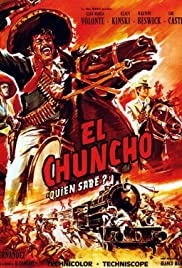
QUIEN SABE? (A BULLET FOR THE GENERAL)
Italy, 1967, 112 minutes, Colour.
Gian Maria Volonte, Klaus Kinski, Lou Castel.
Directed by Damiano Damiani.
Quien Sabe? is a vigorous example from the '60s of the spaghetti western. It was produced at the same time that Sergio Leone was making his mark with the 'Dollars' films and then The Good, the Bad and the Ugly and Once Upon a Time in the West. The star, Gian Maria Volonte starred in some of Leone's films. Here he has a strong role as Chuncho, the Mexican bandit trying to steal and buy arms for General Elias, the Revolutionary General. He is joined by Klaus Kinski (later to be so striking in many films including Herzog's Aguirre, Nosferatu and Fitzcaraldo). Lou Castel has a good role as the American bounty hunter.
The film, in colour and scope, spends most of its first half in set pieces, violent and bloody massacres, train hold-ups, shootouts. The film comes to a more serious point towards the end with scenes of mutual betrayal - the realisation by Chuncho that he has been betrayed and his vengeance on his friend the bounty hunter. Themes of loyalty, friendship, causes and betrayal come to a head in quite a dramatic conclusion. This film illustrates both the strengths and weaknesses of the spaghetti western. Self-indulgence in action and violence spectacle, themes of relationships and the significance of the American and Mexican West. Direction is by Damiano Damiani, a director whose career was largely in making films derivative of other genres - The Tempter (with Glenda Jackson and Lisa Harrow), and in the United States, Amityville II: The Possession.
1. The impact of the Italian spaghetti western? Its looking at the American and Mexican West with European eyes? The homage to American westerns? The originality of the Italian style? This film as a good example of the spaghetti western?
2. Colour photography, Spanish locations, the suggestion of the West? Panavision? Landscapes, action sequences, the use of close-ups and profiles? Special effects? The musical score? The star cast?
3. The conventions of the spaghetti western: the quick establishing of situation, characters and action? The heavy emphasis on violent confrontations? Spectacular attacks and fights? The lack of attention to subtle motivation? The gathering together of themes at the end? The popularity of the spaghetti western?
4. The comparisons of plot with the American western? Characters, bandits, the military? Confrontations? Train robberies? Friendships and loyalties? The role of the Church in Mexico? Government, military, betrayals? The confrontation of hero and villain at the end?
5. The character of Chuncho: Gian Maria Volonte's vigorous presentation of the bandit chief? His pride, laughing? Simplicity and shrewdness? His violent action and cause for getting the guns? Robbing the train, shooting people, the various set-ups and the use of his team for robbing forts and getting away with ammunition? The ambiguity of his friendship with Tate? His understanding of his brother - and the later irony of his brother ready to kill him? The cause of Mexico, the peasants, the Church, anti-military? His saving the life of his friend - especially with the malaria? The final confrontation with the General? The desertion of the village and his being ready for execution? His brother about to kill him and his acceptance of this? His being rescued by Tate? The temptation to be transformed into an American bounty hunter, the money, the night with the prostitute? The final confrontation with Tate at the train and his killing him and raucous running away to further the cause of the Revolution? A subtle characterisation in an unsubtle type of film?
6. The contrast with Tate - the variation on the Man With No Name? Presence on the train? Suit, hat? Enigmatic watching? Youthfulness? His killing people and the puzzle for the audience? The handcuffs? His deceiving Chuncho? Joining the gang? Participation in the various sieges of forts? Shooting, observations? His friendship with Chuncho? The malaria and Chuncho's help? The infatuation with Adelita? His going away? His finally killing the General with the golden bullet? Saving Chuncho's life? His receiving the money from the military? The slick bounty hunter and his success? The irony of his being killed by his friend? Underestimating Chuncho's values and loyalties? His shock in death?
7. The strange character of Santo - the priest with the revolutionaries, Klaus Kinski's manic look, dress, words, cross? The death of the priest and Santo's preaching to the men? His simplicity and the explanation of his intensity by Chuncho? His participation in the raids? His belief in the cause? His preaching at the giving of the medals and leading the siege? His disgust with Chuncho and his readiness to execute him?
8. The revolutionaries and bandits? Their skills in robbing trains? The various sieges? Jealousies within the group? Loyalties to Chuncho? The desertion of San Miguel?
9. Adelita and her place in the group? Her man? The temptation to love Tate? Loyalties and pressures within the group? Her loyalty to Chuncho? Her leading the attack on the fort with the prostitutes?
10. The encounter with Don Felipe and his wife? The lords and the rule of Mexico and the revolutionaries' reaction? The attack of Don Felipe's wife? Adelita and her not wanting to spare her?
11. The screenplay's enjoying itself in its revolutionary tone, siding with the peasants, satirising and caricaturing the military and the government? The indulgence of the massacres?
12. The social points being made about oppression, the shoe-shine boy and Chuncho at the end, Chuncho's seeming transformation and willingness to go to America, to enjoy the fruits of exploitation rather than revolution? His final loyalty to the cause?
13. The popularity in the '60s and '70s of the spaghetti western? The European insight into the American West of the 19th. century? Insight into the traditional American western film?